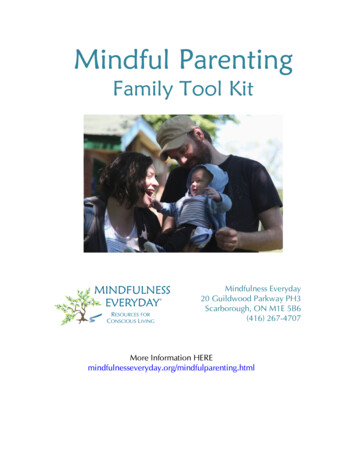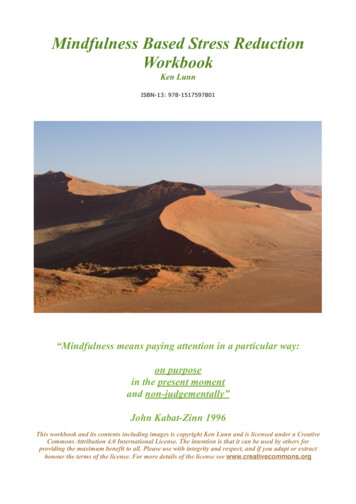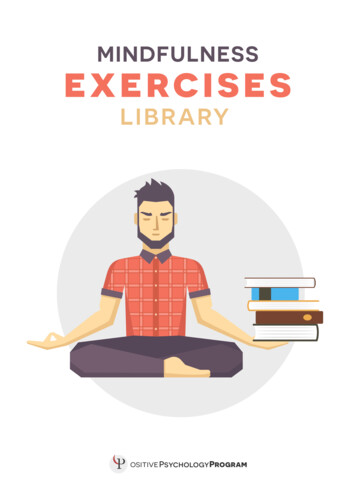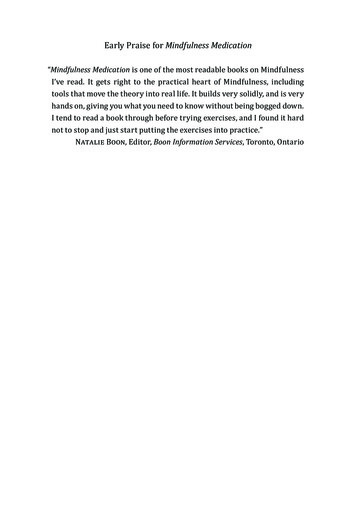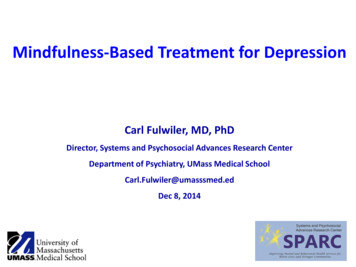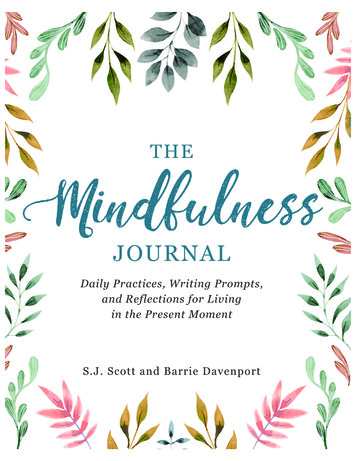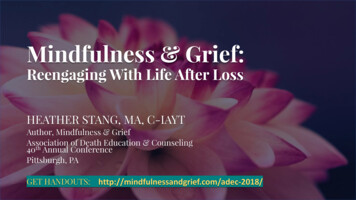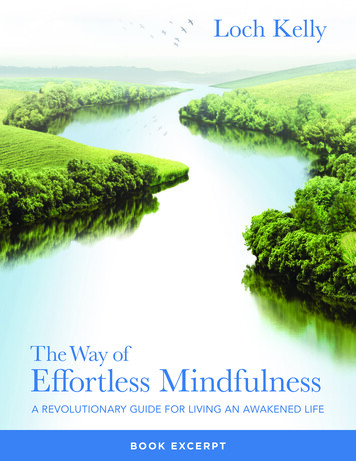
Transcription
Loch KellyThe Way ofEffortless MindfulnessA REVOLUTIONARY GUIDE FOR LIVING AN AWAKENED LIFEB O O K EiXC E R P T
1The Next Stage ofMindfulnessWhat does effortless mindfulness feel like?” Eachperson experiences a different facet of the diamondof effortless mindfulness as it shows its qualities tous freshly each time. A glimpse of effortless mindfulness might initially feel like any of the following: You feel relief. Your mind is wide open andwithout an agenda.Most of us love the feeling of effortlessness.Some of the happiest times in our liveshappen when we flow with the silentmusic of life. The sight of a dancer, athlete, or birdmoving with ease and grace inspires us. What if youcould learn to shift into a level of mind in whichsuffering could be relieved and wisdom, love, andjoy naturally uncovered? What if you could discover a reliable way to access a sense of safety andopen-heartedness that shifts us out of the confusionwe have been so tightly caught in? What if awakening — shifting your consciousness into a morecompassionate way of seeing and being — weresomething you could learn? What if there were anart, a science, and even repeatable methods to livefrom effortless mindfulness? My experience is thatthere are! This reality has been reported by ancientwisdom traditions and by many people I’ve met,and it’s possible for you.Effortless mindfulness is both a natural capacity and a skillful way to connect with ourselves andothers. It is a way of being mindful from a differentlevel of mind than we are used to. There is moreto effortless mindfulness than meditation. Effortlessmindfulness is primarily an off-the-meditationcushion way of weaving together contemplationand compassionate actions. Effortless mindfulnessbegins by opening to a natural spacious awareness inorder to become more wise, embodied, and creative.A new ethical motivation springs from the realization of a loving interconnection with all of life.When I teach effortless mindfulness, I’m oftenasked, “How do I know when I’m really doing it? Your thoughts are less prominent orhave moved into the background. You are free of worry, fear, and judgment. You are able to effortlessly focus onsomething, without concentrating. Your center has moved fromyour head to your heart. You are resting as a field ofseamless awareness that is outsideand within your body. You feel aware from the Nowand able to be aware of the past,present, or future when needed. Everything seems to be flowing easily,happening naturally without any effort. You experience a sense of joy and well-being not related to what is happening. You are aware from boundless,interconnected, loving presence ratherthan a detached point of view. You feel aware from nonconceptualawareness rather than thought. You know all is well, with nothingmissing and nothing to push away.
Introducing Mindful GlimpsesWhen we do traditional sitting meditation, it cantake a long time for the mind to settle. In contrast,here’s an example to give you the direct experienceof the immediacy of a glimpse.One of my main techniques for connecting andexperimenting with effortless mindfulness isthrough what I call mindful glimpses. Many peoplehave told me that this is one of the simplest, mostelegant, and effective ways to learn effortlessmindfulness. A glimpse is a type of shifting, letting go, dropping, or stopping to allow a naturalclarity and connectedness to emerge. Glimpses arethe initial effortless effort of opening, surrendering, resting, or turning awareness around to findour open mind and open heart. They are “micromeditations” or “rest stops” where we can refresh orreboot our whole body-mind system. A glimpse isnot an insight from our conceptual mind; it is thedirect experience of the essential peace, love, andwisdom that’s always been here. It is a paradigmshift, an identity shift, a shift of consciousness to anew view and a new you that feels true. In TibetanBuddhism, glimpsing is sometimes called “flashingon awakened heart-mind.”A mindful glimpse is similar to a Zen koan, asimple inquiry that can’t be solved through logicand that takes you out of your conceptual mind andsmall self. Unlike a koan, a glimpse does not startwith thinking. It starts with awareness unhookingfrom thought. The effortless mindfulness glimpsesI offer in this book can be done with eyes closed oropen anytime during your day. They initially takefrom ten seconds to ten minutes to do, but theyshift you into a new operating system that allowsyou to enjoy their continuous benefits. The primaryway of practicing effortless mindfulness is smallglimpses, many times.You can see glimpses as invitations to pause andshift your awareness, to have a chance to taste thepeace beyond conceptual understanding. Several ofmy students have told me that dropping into onesmall glimpse has been as life changing as going on along meditation retreat. I have found that differentglimpses work well for different people dependingon their learning styles. So if one glimpse in thisbook doesn’t click for you, no worries. Just keepreading and try the next one.GLIMPSEWordless Awareness1. Allow your awareness to movefrom reading these words tohearing the sounds around you.2. Now shift from hearing soundsto an interest in the open,objectless space all around.3. Rest into this alert wordless awareness. ¾After you have read the mindful glimpses in thisbook, I suggest you record the ones you like best inyour own voice, at a pace that seems right for you,and then listen to your own voice lead you home.You May Not Know ThatYou Know This AlreadyWhen I describe effortless mindfulness, some peopletell me they’ve had this feeling walking in nature,playing music, gardening, making love, driving acar, or during a special moment in their past thatthey long to return to. Many of us have been intuitively practicing some form of effortless mindfulnessthroughout our lives — while being creative, withloved ones, or while playing sports. And some of ushave experienced it when we suddenly became calmand clear during a crisis.For example, we may have shifted into effortless mindfulness while hiking with friends. Whilehiking, we may notice that as soon as we reach thesummit of the hill, our goal seeking stops for thatmoment. Our identity as a seeker relaxes as we lookat the sky and feel our awareness and mind open2
into it. We might look at our friends and feel a senseof connection and open-heartedness. We feel fullypresent, with no problems to solve and nothing topush away. We look at the trees and feel connectedand part of nature. Our separate sense of self relaxesto reveal a wordless experience that rests in a placeof “all is well.” At times like these, we feel freedom,clarity of mind, joy, connection to nature and otherpeople, and a sense of well-being. However, weoften associate these enjoyable qualities with anactivity or place without realizing that the source isalready available within us.Because we don’t always know that the source ofour joy and freedom is already available to us, wemight later say, “I miss that incredible feeling I hadwhile hiking last week. I’ll have to wait until mynext vacation to return there.” Yet, if we try to recreate an experience by doing the same activity again,our expectation may keep us from relaxing the seeking mind enough to allow effortless mindfulness tobe revealed.Without knowing it, most of us do our favoriteleisure activities to experience effortless mindfulnessand its natural qualities of freedom and joy. We dowhat we love to experience effortless mindfulness.However, effortless mindfulness and its qualities arenot dependent on what we do or where we are. Soeven at work or in the New York City subway, wecan discover the inner freedom, love, and claritythat are who we truly are.of that day. Hear the sounds, smellthe smells, and feel the air on yourskin; notice the enjoyment of beingwith your companions or by yourself;recall the feeling of walking those lastfew yards toward your destination.2. Visualize and feel yourself as you havereached your goal and are looking outover the wide-open vista. Feel thatopenness, connection to nature, sense ofpeace and well-being. Having reachedyour goal, feel what it’s like when there’sno more striving and nothing to do. Seethat wide-open sky with no agenda tothink about, and then simply stop. Feelthis deep sense of relief and peace.3. Now, begin to let go of the visualization,the past, and all associated memoriesslowly and completely. Remain connectedto the joy of being that is here within you.4. As you open your eyes, feel how thewell-being that was experienced thenis also here now. It does not requireyou to go to any particular placein the past or the future once it’sdiscovered within and all around. ¾Effortless Mindfulness IsLike a Flow StateGLIMPSEMemory DoorEffortless mindfulness is not only experiencedduring meditation or relaxation. When we openinto it, we find a new balance between being anddoing. In this age of multitasking, effortlessnessmay be hard to understand, let alone value. Thereis a Chinese phrase, wei wu wei, often translatedas “effortless effort” or “effortless doing,” whichis activity that is natural and in harmony witheverything. In Tibetan Buddhism, effortlessmindfulness is sometimes called non-meditationbecause we discover the spontaneous flow ofwisdom and action. Effortless mindfulness isFirst, read this mindful glimpse below. Next,choose a memory of a time you felt a sense offreedom, connection, and well-being. Then do thismindful glimpse using your memory as a door todiscover the effortless mindfulness that is alreadyhere now.1. Close your eyes. Picture a time whenyou felt well-being while doingsomething active like hiking in nature.In your mind, see and feel every detail3
compatible with an active, engaged life since it canbe practiced with eyes open, anywhere. You canlook out of your window at work and, in a fewminutes, shift from a sense of feeling worried orfearful into effortless well-being and compassionateconnection. You can return to your activity, nowoperating from effortless mindfulness.You may know a form of effortless mindfulnessas “being in the zone” or in a flow state. Flow is oneof the most important areas of research in contemporary psychology. Many of us consider flow anoptimal way of functioning while doing complextasks. In 1990, psychologist Mihaly Csikszentmihalyi, PhD, published his seminal book, Flow: ThePsychology of Optimal Experience, based on years ofresearch. Csikszentmihalyi and his team studiedthe ways people engage in sports, art, music, scientific research, and other tasks in order to enter astate of flow.Csikszentmihalyi points to these seven qualitiesof flow:Most people master the task they are good at toenter the flow state. But in effortless mindfulness, wefirst shift into an integrated flow state, and then we cando any task from heart knowing.GLIMPSEFrom Your Heart1. Pause . . . notice your next out-breath . . . then, with the nextin-breath, let your awareness movefrom your head down to your heart.2. What is it like to knowfrom your heart? ¾Introducing Awake AwarenessTo practice any form of mindfulness, we shift ourawareness and level of mind to see things differently. Deliberate mindfulness uses attention andour observing mind, whereas effortless mindfulnesscomes from a particular level of mind and awareness that is not as familiar. Among other names,this unique level of mind and awareness has beencalled source of mind, nature of mind, unity consciousness, natural awareness, true nature, optimalmind, and heart-mind. I will call this level ofawareness and mind awake awareness.Awake awareness is the foundation of knowing,like the quantum field from which individual particles of thoughts or waves of feelings appear. Awakeawareness is formless and contentless, yet knowing.At first, awake awareness feels like the absence ofthought and an opening into more space. Then, wenotice an alertness, a clarity, and a feeling as if we areaware from the open space. It’s not the same experience as knowing from thought, and it does not feellike “I” am aware. It is more as if we’ve shifted intoan awareness that is already awake by itself, withoutour help. This is why it is called awake awareness.Here’s a deeper look at what awake awareness isand isn’t: Knowing that an activity is doable, thatour skills are adequate to the task Being completely involved in andfocused on what we’re doing A sense of ecstasy Great inner clarity: knowing what needsto be done and how well we’re doing A sense of serenity: no worriesabout oneself; a feeling of goingbeyond the boundaries of ego Timelessness: being thoroughlyfocused on the present so thathours seem to pass in minutes Intrinsic motivation: whatever producesflow becomes its own reward14
Awake awareness is our primary level ofyet it is our optimal level of knowingand the foundation of our identity. Itis experienced in those times when wepeek beyond the veil of our conventionalexperience and notice the silence thatis the fabric of our everyday reality.knowing, which is prior to thinking, includesthinking, and is also beyond thinking. Awake awareness is not an altered,transcendent, or even a meditative state. It isnot attention, and it’s not mindful awareness;neither is it mindlessness or zoning out. Awake awareness unfolds into open-hearted awareness, and then the naturalqualities of well-being, compassion, andintuitive intelligence are revealed. There are many types of consciousness(patterns of experience) such as emotionalconsciousness, hearing consciousness, andthinking consciousness. Awake awarenessis what makes consciousness conscious.Thoughts, feelings, and sensations aredancing patterns made of awake awareness.Awake awareness is the most important discovery wecan make on our path of effortless mindfulness. However, in this approach, awake awareness is not the endgoal, and we do not seek to remain in a detached witness state or a state of pure awareness. Instead, awakeawareness will unfold into awake awareness-energyembodied and into open-hearted awareness. Similarly, as we will explore later in this book, effortlessmindfulness could be called “effortless mindfulnessembodied” or “effortless heart mindfulness” as welearn to live an awakened life. Awake awareness is clear and open,resting as peace of mind, whiletrusting that information or insightwill come when needed. Awake awareness is the same in all ofus, yet our individuality arises fromit. Rather than looking to our thoughts,memories, personality, or roles toidentify ourselves, through effortlessmindfulness we come to know awakeawareness as the primary dimension ofwho we are. Once we experience awakeawareness as the foundation of ouridentity, we experience our conditionedthoughts, emotions, and sensations aswaves within the ocean of our life.GLIMPSEBackground Awareness1. Take one slow, deep breath.2. Let out a sigh.3. Now, let your awareness open todiscover the background awarenessthat is already effortlessly awakeand aware without your help. Awake awareness cannot be harmedby any strong emotional state. Inother words, awake awareness is thesource from which all emotionalstates arise and are experienced. Wedon’t have to leave or change ourfeelings to find essential well-being.4. Notice that you can effortlessly focusfrom this background awareness. ¾The practice of effortless mindfulness begins asa simple shift or letting go to discover a naturallyawake awareness that is already present all aroundand within us. One of my students described the Awake awareness is nonconceptual,invisible, formless, boundless, and timeless,5
experience like this: “I’m not aware of an open mindand an open heart. I’m aware from an open mind andheart that is connected to everything.” When we tapinto this feeling of viewing from our wordless awakeawareness, it opens us to a relief from suffering, natural joy, and compassionate connection with peopleand the world around us.We have been taught that our intelligence, identity, and safety are based on developing and beingcentered in thought-based knowing, or what I willcall our small mind. When we shift from our smallmind to awake awareness as the source of mind, wediscover that we are already effortlessly mindful.Effortless mindfulness is the way of knowing, creating, and relating from awake awareness. Althougheffortless mindfulness begins by letting go of everything, we ultimately become embodied, energetic,loving, and fully human.GLIMPSEEyes of Awareness1. With a soft gaze, simply seewhat is here in front of you.2. Notice the awareness that islooking through your eyes.3. Now close your eyes and noticethe same awareness that waslooking out is still here.4. Simply rest as this wordless awareness,which is now aware of itself.5. Without creating a thinker, bethe awareness that welcomesand includes everything. ¾Loch Kelly, MDiv, LCSW, is a leader in the field of meditation and psychotherapy. Heis author of the award-winning Shift into Freedom and founder of the Open-HeartedAwareness Institute. Loch is an emerging voice in modernizing meditation, socialengagement, and collaborating with neuroscientists. For more, visit lochkelly.org.
The effortless mindfulness glimpses I offer in this book can be done with eyes closed or open anytime during your day. They initially take from ten seconds to ten minutes to do, but they shift you into a new operating system that a
